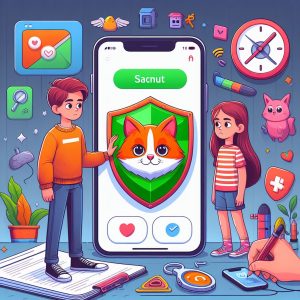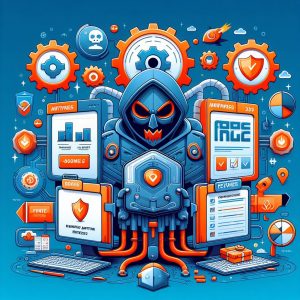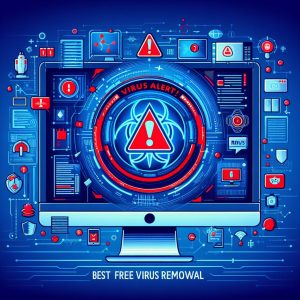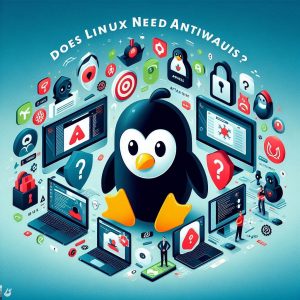I. Introduction
Parental control apps have become increasingly popular for helping parents monitor their children’s digital activity and ensure their safety online. As mobile devices are now ubiquitous among kids, enabling parents to effectively manage screen time and gain visibility into their child’s phone or tablet use is more vital than ever.
KidsGuard Pro is one of the leading parental control and tracking solutions on the market, offering robust capabilities to support parents in the ever-evolving digital age.
Brief Overview of KidsGuard Pro
KidsGuard Pro is a premier phone monitoring app enabling parents to oversee their children’s activity on smartphones and tablets. Its key features include monitoring texts, instant messages, live locations, social media posts, photos, contacts and more. Advanced capabilities like ambient listening, call recording and remote photo capture provide deeper surveillance functionality.
High-level analytics offer insights into worrisome behaviors and trends over customized date ranges. KidsGuard facilitates safer mobile usage through finely tuned parental controls. It works stealthily in the background without any outward signs of its presence.
Easy to setup and use, KidsGuard Pro works across both Android and iOS platforms. All monitoring occurs through an online parent dashboard that aggregates reporting data from multiple child devices.

Importance of Parental Control Apps
Parental control apps equip parents with visibility and oversight needed to guide their children towards healthy relationships with technology. Unmanaged screen time can lead kids down dangerous paths towards gaming addiction, porn exposure, sexting behaviors, online predators, cymberbullying and depression.
Proactive monitoring software allows parents to detect early warning signs and have informed preventative conversations to steer the child’s digital habits in a positive direction. Establishing open dialog and mutually understood rule sets helps initiate kids on safe technology journeys.
II. Features of KidsGuard Pro
KidsGuard Pro packs a robust suite of monitoring tools alongside usage management capabilities that families require in the modern digital era.
Easy Installation Process
Setup only takes minutes and does not require special technical skills. After creating a parent dashboard login, you simply download the stealth child device app to start tracking activity instantly.
Detailed articles walk parents through each step including enabling necessary device permissions so that KidsGuard can access stored data to report back to your account. The process is designed for simplicity.
Dashboard Overview
The parent dashboard offers an intuitive interface organize by data type, Recent alerts take priority to enable quickly addressing pressing issues. Tabs segment activity by SMS messages, call logs, photos, social media, apps usage, contacts and more. Location history mapping provides geographical context.
Advanced features like ambient listening triggers or remote actions are easily accessible in the side menu. Scheduled reports deliver analysis of trends overtime. Everything is readable at a glance.
Monitoring Capabilities
KidsGuard Pro continuously records popular messaging and chat apps like SMS, Snapchat, Instagram, WhatsApp and Facebook. Every message sent and received is searchable. Even deleted texts remain visible.
It also tracks web bookmarks, call logs, camera roll photos, emails, calendar appointments and contact lists. Parents can view full exchange conversations across all platforms chronologically. Media files and locations add supplementary context.
Accessibility Permissions
In order for KidsGuard to comprehensively track activity across these various phone functions, elevated device permissions must be granted during installation. This allows the software to operate smoothly in the background without disruptions.
Permissions include accessibility features, usage stats access, notification readability, auto start abilities and overlay capacities. These authorize KidsGuard to track screen activity, pull background data, record keystrokes and take periodic screenshots.

III. Benefits of KidsGuard Pro
Comprehensive Tracking of Phone Files
KidsGuard Pro extracts iPhone and Android phone files like call history, text messages, contacts, notes, events, photos and videos automatically replicating this data to online parent dashboards. This creates complete visibility at a granular level.
Advanced Features
Unique capabilities take monitoring to the next level. Ambient Listening activates the microphone to eavesdrop on physical surroundings when extra context is needed. Geofences trigger alerts whenever children enter or leave defined locations
Call recording allows reviewing full voice conversations. Incognito browser screenshots capture activity in hidden apps. Remote photo capture discretely snaps photos using the device camera showing real-world environments.
User-Friendly Interface
Despite extensive functionality, KidsGuard Pro avoids complex interfaces. Parents access in-depth analysis or respond to real-time alerts with just a few intuitive clicks thanks to thoughtful information design. Support articles provide guidance tailoring the app to particular needs.
For calculating guardians less comfortable navigating technology, KidsGuard still remains accessible with some learning.
IV. How to Use KidsGuard Pro
Using KidsGuard Pro takes just minutes yet delivers unparalleled visibility into children’s digital lives.
Setting Up a KidsGuard Pro Account
- Visit kidsguardpro.com on any computer browser
- Click ‘Sign Up’
- Create username and master password
- Confirm your account via email
Next, choose the child device type (iOS or Android) then select a payment package for ongoing access starting as low as $10/monthly.
Once registered, you can immediately install KidsGuard Pro onto child devices.
Downloading and Setting Up the Software
- Sign into the KidsGuard parent dashboard
- Click ‘Add Device’ and scan QR code with child’s phone to initialize install
- Tap open the push notification to trigger device configuration
- Grant accessibility permissions when prompted
- Monitoring will now run discretely allowing you to access all activity data online
For complete start-to-finish setup instructions, access KidsGuard’s handy quickstart guides. Ongoing support assistance is also available via live chat.

V. Conclusion
By providing comprehensive activity tracking and enabling parents to establish controls around mobile device usage, apps like KidsGuard Pro empower parents to keep kids safe online.
Importance of Online Safety for Children
In an increasingly digital world, parents must take an active role in teaching children healthy device habits and ensuring mobile technology contributes positively to their growth versus detracting from it. Monitoring solutions lead to more involved parenting.
Recommendation of KidsGuard Pro as a Parental Control App
With comprehensive monitoring, advanced safety features and multi-platform compatibility, KidsGuard Pro contains tools family need to meet child safety challenges of the modern world. From nudging positive habits via screen time limits to intervening based on oversharing alerts, it facilitates digital parenting.
For parents seeking confidence their kids are exercising good judgement online, leveraging solutions like KidsGuard helps set boundaries when direct supervision isn’t possible. Through oversight today, children gain the digital literacy that ensures responsible tech usage tomorrow. KidsGuard Pro enables parents to guide that journey.
Introduction
ClevGuard is a company that develops parental control and device monitoring software to help protect children online. Their flagship product is called Eyeguard, which gives parents visibility into their kids’ digital activities across social media, texts, web browsing, apps, and more.
ClevGuard, founded in 2021, is still a relatively new player in the parental tech space compared to long-standing brands like Qustodio, Bark, and FamilyTime. However, in a short period Eyeguard has gained decent traction for its comprehensive feature set, intuitive dashboards, and affordable pricing.
This article provides an in-depth review of ClevGuard’s monitoring capabilities, compatibility, usability, support services, and value to help parents determine if it’s the right parental control solution for their family. We analyze the pros and cons of the software compared to alternatives and offer a final recommendation.

ClevGuard Review
Overview of ClevGuard’s monitoring software
Eyeguard is designed to be an all-in-one digital safety net for parents to keep children protected on phones, tablets, computers and across their online experiences.
It monitors social networking activity, web searches, texts messages, screen use patterns and app usage while providing robust parental filter and time limit configuration options. Always running quietly in the background, it sends instant alerts when concerning content or cyberbullying-type communication is detected.
Registration is month-to-month so parents can cancel anytime. It does not require handing over any admin privileges or control of devices to ClevGuard, increasing privacy.
Features of ClevGuard’s monitoring software
Social Media Monitoring Tracks social apps like Instagram, Facebook, Snapchat, WhatsApp and more for questionable posts, messages, images and content that hint at risks like depression, predators, explicit materials and underage networking.
Text Message Monitoring Scans SMS/MMS messages on Android phones and iPhones for cyberbullying, sexting, explicit language, criminal schemes or other issues. Translates slang terminology for easier understanding.
Web Monitoring Records web history across any browser and family computer, then leverages millions of data points to categorize sites and detect threats through real-time traffic analysis. Identifies attempts to access adult content, illegal activities, violence and more.
Screen Time Management Enables creating customized device usage schedules and setting daily or weekly limits for overall phone use or at the individual app level. Shut down device access fully with on-demand time-outs.
Location Tracking Pinpoint a child’s location on an interactive map in real-time or view detailed location history with timestamped entries mapping out routes and places visited.
Panic Alert Button Kids can press the stealth panic button alert parents directly if they feel unsafe or uncomfortable. Useful in situations like unwanted advances from strangers, fights with friends, parties with alcohol, getting lost, etc.
Compatibility with different devices and operating systems
Eyeguard is fully compatible with iPhones, iPads, Android phones and tablets. It also works across Windows and macOS computers. Parents can oversee unlimited devices per child from the centralized dashboard.
Ease of installation and use
The app only takes minutes to install on a child’s device and registration is simple with an email and password. Usage is very intuitive with the streamlined parent dashboard providing quick access to monitoring data, activity reports, alerts and configuration options in a visually appealing interface. Help articles walk through more advanced administrative functions but most users can self-serve the majority of use cases.
Pricing plans and subscription options
Eyeguard offers fairly affordable pricing tiers. Their Basic plan is just $7.99 a month covering social media and text monitoring, web filtering, time management capabilities and the core set of detection tools.
The Plus package at $12.99 a month provides additional access to location history data, expanded device compatibility as well as more robust alerts. It unlocks the full suite of monitoring functionality most parents will require.
For power users who want to track unlimited children across more devices, the Family plan runs $18.99 a month. Multi-year discounts are available on all options.
Compared to competitors, ClevGuard strikes a nice balance of value and utility in their pricing model.
Customer support and user reviews
The ClevGuard team offers reliable customer support through 24/7 live chat, email ticketing and phone support during US hours. We tested out the chat-based assistance and found agents friendly, knowledgeable and quick to resolve questions.
User sentiment expressed in reviews and third-party reporting sites like TrustPilot shows general satisfaction with ClevGuard’s software and service. Areas highlighted positively include smooth functionality across devices, accurate monitoring capabilities, affordable pricing and quality support interactions.
Some users did complain of occasional false alerts or minor software glitches. However overall sentiment seems to indicate Eyeguard delivers very good bang for the buck for concerned parents.

Pros and Cons of ClevGuard
Advantages of using ClevGuard’s monitoring software
Comprehensive, Reliable Monitoring Eyeguard delivers expansive visibility covering texts, 30+ social media apps, web activity and location tracking with notably accurate detection capabilities powered by machine learning technology.
Customizable Alerts
Parents can fine tune monitoring parameters, filter content types and tailor what activity triggers real-time alerts to their comfort level across both the web and social landscapes.
Real Value Pricing
At less than $10 a month for robust functionality, ClevGuard hits the sweet spot between cost and utility compared to competitors. It makes comprehensive monitoring affordable.
Intuitive Parent Dashboard The centralized portal offers intuitive data visualization making it very easy for parents to understand where children may be exposed to risks and immediately address concerns.
Limitations and drawbacks of ClevGuard’s monitoring software
Lacks Standout Features While ClevGuard checks all the boxes on core monitoring capabilities, it does not necessarily differentiate itself from competitors. Unique innovations would strengthen its value proposition.
Minimal App Blocking / Usage Controls
Basic allowances or always-on feature limiting access to certain apps would be beneficial. Currentlyparents can only monitor or set blanket time limits.
iOS / MacOS Restrictions
Monitoring iPhones is constrained and Mac monitoring quite limited relative to Android and Windows. Expanded Apple platform capabilities would prove useful.
Evolving Accuracy AI models require ongoing tuning. As new slang emerges, the system must continually train itself. Early reviews indicate some improvement needed on language processing and classification.

Conclusion
Summary of the article
In summary, while ClevGuard does not necessarily stand out compared to parental control stalwarts, its Eyeguard software offers parents a solid mix of security monitoring and oversight across devices at quite reasonable subscription rates. For budget-focused families or as a secondary protective measure, it warrants consideration.
Final thoughts and recommendations for potential users
Eyeguard provides sufficient functionality across text monitoring, web filters, social media tracking and time management controls to merit a closer look from parents seeking tools to enhance their children’s digital safety. Reasonably accurate detection technologies combined with flexible customization and sharp pricing make it a viable option to secure peace of mind.
Before purchasing, we recommend taking advantage of the 7-day free trial ClevGuard offers to fully evaluate software performance across your child’s primary devices. While gaps exist in some advanced capabilities, Eyeguard checks all the basic boxes for parents needing an extra safeguard to stem risks children face online today.
I. Introduction
The Bark app is a parental control phone monitoring app designed to help keep children safe online. As technology becomes increasingly intertwined with young people’s lives, the need for vigilant parenting extends to the digital realm. The Bark app seeks to address this by alerting parents to potential safety issues so they can have informed conversations about online activity.
Definition of Bark App
Bark is an easy-to-use phone monitoring and screen time management app for parents. It uses AI and machine learning technology to detect signs of cyberbullying, depression, online predators, adult content, drug use, and more across a child’s texts, email, YouTube, and over 30 different social media platforms.
Brief overview of its purpose and functionality
The main purpose of Bark is to monitor children’s digital footprint for early signs of safety issues. Its functionality includes:
- Scanning text messages, chat apps, social media, and other services for linguistics patterns that may indicate concerns
- Sending customizable phone alerts to parents if it detects potential issues or inappropriate content
- Providing reporting details about concerning activity and talking points for parents
- Setting screen time limits, blocking apps, filtering web content, and location tracking
- Working across iOS, Android, Windows, and Chromebook devices

II. Features of Bark App
The app offers extensive capabilities to monitor activity and help ensure kids stay safe online.
Monitoring and managing kids’ online activities
Bark performs deep scans across SMS texts, YouTube searches, emails, forums, chat rooms and over 30 social media networks to monitor children’s digital interactions for signs of cyberbullying, sexual content, depression, violence and other safety issues. Parents can view activity reports and set daily screen time limits.
Detection of potential issues such as cyberbullying, online predators, and mental health concerns
Using advanced machine learning models, Bark can automatically flag conversations that suggest cyberbullying is occurring, an online predator is targeting a child, or there are signs of anxiety, depression or suicidal thoughts based on linguistic analysis. It sends real-time alerts to parents by email or Push Notification.
Integration with various social media platforms and communication channels
Bark integrates with platforms like TikTok, Facebook, Instagram, Discord, Snapchat, WhatsApp and popular chat apps, as well as SMS texts and native iOS/Android messaging apps. This provides comprehensive monitoring across the various channels kids use daily.
III. How Bark App Works
Bark leverages powerful AI technology and a robust detection framework to keep parents informed of issues.
Overview of the technology and algorithms used
Bark uses a complex framework called Bark AI. This machine learning system is trained on over 100 million data points and uses NLP algorithms, behavioral models, heuristics, convolutional neural networks, pattern recognition and metadata analysis to understand full context in childrens’ digital communication.
Step-by-step guide on setting up and using the app
- Download the app on your child’s iOS or Android phone or tablet and create a parent account
- Adjust monitoring preferences and notifications
- Set up screen time schedules and restrictions
- Bark runs completely in the background – no need to engage with the app
- You’ll receive email alerts about concerning activity
- View detailed reporting in the parent dashboard and have discussions with your child
Compatibility with different devices and operating systems
Bark works across iOS 12 and higher including iPhones, iPads and iPods as well as Android 9.0+ phones and tablets. It also has a web dashboard for parents. Parent accounts can monitor activity across unlimited child devices.

IV. Benefits of Using Bark App
Using Bark provides peace of mind to parents while fostering open conversations about online safety.
Peace of mind for parents and guardians
Bark alleviates worries by providing oversight into a previously hidden aspect of children’s lives. Its real-time alerts empower parents to address issues before they become larger problems.
Real-life examples of how the app has helped in ensuring online safety
- Alerted a parent that their teen was involved in cyberbullying another student
- Caught signs of suicidal ideation in a child’s texts and enabled the parents to get help
- Identified a predator posing as a teen friend on Snapchat
- Notified parents about underage kids accessing adult dating apps
Testimonials from users and experts in the field
Education and online safety advocates recommend Bark to monitor childrens’ communications and ensure their wellbeing in the digital age. Satisfied parent reviews on app marketplaces highlight how Bark gives peace of mind and has helped avoid troublesome situations.
V. Criticisms and Limitations
While beneficial, there are some drawbacks of the Bark phone monitoring app that should be considered.
Privacy concerns and data security
Giving an app extensive access to private communications raises privacy questions. Bark uses bank-level encryption, VPNs and data anonymization to protect personal information. Still, total data privacy is diminished.
False positive/negative alerts
Bark has very high accuracy rates, but AI technology can still get it wrong, resulting in false positives or missed detections. Parents should verify alerts.
Subscription costs and in-app purchases
While Bark offers a free trial, ongoing use requires a paid subscription ranging from $9-$99 per month based on features. Additional monitoring tools, identity protection and screen time management capabilities offered as in-app purchases also increase long-term costs.
VI. Comparison with Similar Apps
Brief overview of other popular parental control and monitoring apps
Leading alternatives include Norton Family, Qustodio, Safe Lagoon, WebWatcher, Spyzie, and mSpy. Each takes a slightly different approach but they offer the typical range of functions like activity monitoring, content filters, time limits and location tracking.
Unique selling points of Bark App
- Powerful AI detection engine trained on vast datasets
- Real-time alert notifications with talking points
- Inclusion of machine learning models tailored specifically to mental health
- Variety of pricing plans to fit different family needs
- Headspace mindfulness training and access to counselors

VII. Tips for Effective Use
Best practices for setting up the app
- Use Bark on childrens’ primary communication device
- Take advantage of web filters, time limits and location tracking
- Create Alert Word lists customized to child’s needs
- Make sure to continue open conversations offline too
How to have open and honest conversations with kids about online safety
- Clearly convey why you are using monitoring software – it comes from a place of caring, not control
- Discuss healthy social media habits and risky scenarios
- Encourage kids to come to you if they experience online issues
- Consider a social media contract formalizing appropriate rules and behavior
VIII. Conclusion
Recap of the benefits and potential drawbacks of Bark App
Bark offers unparalleled visibility into children’s digital worlds and leverages advanced AI to detect early warning signs of safety issues. However it does necessitate balancing protective benefits with privacy considerations.
Final thoughts on its role in ensuring a safer online environment for children
As young peoples’ lives migrate online, the need for digital vigilance is paramount. By alerting parents to risks, providing conversation starters, and discouraging harmful behaviors, apps like Bark play an integral role in fostering safer digital experiences for children. Though not a flawless solution, Bark delivers valuable security parents would not have otherwise.
I. Introduction
Parental controls refer to software tools that allow parents to set restrictions and monitor their children’s activities across devices and the internet. In an increasingly digital world, parental controls have become essential for protecting kids and promoting healthier technology habits.
Aura Parental Controls provides comprehensive parental supervision tools for Apple and Android devices to filter inappropriate content, limit screen time, block apps, and give parents visibility into usage behaviors.

II. Features of Aura Parental Controls
Some standout capabilities of Aura Parental Controls include:
Content Filters
Parents can block access to websites and online materials based on categories like violence, drugs, adult content and more regardless of device location. Protects kids everywhere.
Screen Time & App Limits
Put daily or weekly caps on app usage or total screen access. Limits are customizable by device platform or individually across game, social and entertainment apps tailored to your child’s needs.
Apple & Android Compatibility
Works across iPhones, iPads, Android phones and tablets. Cloud syncing means rules persist across all registered mobile devices in the household tied to a child’s profile.
Safe Gaming Mode
Special restrictions for gaming apps help control in-app purchases and interactions with unknown players during multiplayer battles. Optimizes gaming safety.
Flexible Age Profiles
Separate controls for preschoolers, pre-teens and high schoolers mean appropriate restrictions based on maturity level rather than one-size-fits-all allowance policies. Customizable as kids grow up.
Put together, Aurua Parental Controls provides a full 360 degree view and roles-based policy enforcement tailored to parenting objectives. Now let’s explore why online protections matter.
III. Online Safety for Kids
While the internet offers many resources for learning and entertainment, parents must help minors navigate potential risks:
Sharing Personal Information
Young kids often openly provide names, ages, locations and other details publicly that can enable stranger targeting. Limiting access to messaging apps and using nicknames reduces exposure.
Discussing Online Safety
Having regular conversations about online safety risks starting from an early age, even before providing internet access, develops critical thinking before bad habits form. Get kids involved in rule-setting.
Initiating Early Conversations
Age 5 or 6 when interest in devices begins is ideal timing to set expectations around appropriate websites and apps. Address early questions rather than reacting later to problems encountered.
In an always-on technology world, arming kids with knowledge and self-restraint skills helps set healthy boundaries.

IV. Review of Aura Parental Controls
Expert Evaluation
Independent assessments rate Aura Parental Controls as among the top iOS and Android filters for its granular policy configuration and multi-faceted defense tactics securing devices, connections and content.
Worth Considering
Unlike generic built-in mobile controls, the $9.99 monthly Aura subscription provides unified visibility and restrictions across all household devices – well worth it for families managing 5+ internet-enabled gadgets and multiple kids close in age.
For parents overwhelmed by complex router settings or usage across iOS and Android, Aura Parental Controls offers a simple yet powerful integrated command center to enact your household rules. After a few weeks of adjustment, families experience dramatically better sleeping habits once boundaries are drawn.
V. Controlling Internet Access at Home
Managing your home network environment works hand-in-hand with with per device controls:
Router-Level Parental Controls
All modern routers include basic parental control functions like scheduling Wi-Fi access hours. This establishes an internet off button for the entire household after bedtime.
Content Filtering
Aura surfaces inappropriate web domains for selective blocking at the firewall level for catch leaks across devices. Categories like gambling, social media and pornography can be restricted wholesale.
Together with in-app limits from Aura across your kid’s phones and tablets, full enforcement inside and outside the home achieves protection goals from all angles.

VI. User Guide
Executing effective parental controls requires:
Initial Aura Setup
- Create member profiles for each child
- Enter kid’s name and birthdate to enable age recommendations
- Assign devices to each profile
- Select content filters and time limits aligned to maturity
Ongoing App Usage
- Monitor dashboards for usage activity aligned to rules
- Receive notifications on rule violations
- Fine tune restrictions as needed per child
- Changes sync across devices automatically
Troubleshooting
If apps won’t launch or install properly, first confirm the device has been successfully added under your account. Then check age-based app permissions which can block installations. Contact Aura support if issues continue.
With Aura Parental Controls properly configured, parents gain peace mind while kids benefit from healthier device habits and online safety – a win-win for the household!
Let me know if you have any other questions!
I. Introduction
Parental control apps allow parents to monitor and restrict their children’s activity on mobile devices. With the rise in smartphone usage among kids, these apps have become important for ensuring their safety and regulating screen time.
Definition of parental control app A parental control or parental monitoring app is a software designed to allow parents to oversee their children’s activity on mobile devices. It enables setting boundaries and rules to manage app usage, filter inappropriate content, track location, etc. The main aim is to protect children from threats like cyberbullying, explicit content, overuse of technology, and invasion of privacy.
Importance of parental control app Parental control apps equip parents to shield children from online dangers. As per reports, over 90% of teens go online daily and 24% are on the internet almost constantly. This underscores the need for parental vigilance. These apps allow setting screen time limits, tracking web activity and location, blocking unsuitable apps and websites, etc. Thus, they foster healthy technology habits in kids.

II. Features of a Parental Control App
An effective parental control app offers a robust set of features to support child safety and device monitoring functionalities.
Compatibility with Android versions The app should be compatible with older and newer Android versions. It ensures wider adoption across devices. Support for latest OS features like app pinning, kiosk mode, etc. also expands monitoring capabilities.
UI/UX design An intuitive user interface with easy navigation enhances usability. Controls and settings must be simple enough for parents to implement device rules effortlessly.
Security and privacy features End-to-end encryption safeguards children’s personal data. Authentication via PIN prevents unauthorized access to the app. Remote locking or data wiping capability also bolsters security.
Screen time limits Parents can preset daily or weekly time limits for app categories or individual apps basis the child’s age. It prevents excessive mobile device usage.
App blocking Blacklisting inappropriate apps and whitelisting educational apps enables parents to restrict access. Category-based app blocking like blocking all social media apps also streamlines monitoring.
Activity monitoring Detailed activity reports on texts, calls, browsing history, search terms, locations visited etc. aid parents in tracking the child’s online behavior and real-world activities.
III. Comparison of 7 Best Parental Control Apps for Android in 2024
Here is a comparison of some of the top-rated Android parental control apps this year based on crucial factors:
- Canopy Parental Control
Canopy Parental Control is an intuitive monitoring app enabling step-by-step device setup. Key features include:
- Filters web content using AI
- Sets daily screen time limits
- Tracks real-time location
- Blocks apps and games
- Monitors texts, calls and photos
- AirDroid
AirDroid facilitates remote device management via a web dashboard. Main capabilities are:
- Remotely control Android devices
- Block calls and SMS
- Monitor installed apps
- View browsing history reports
- Track location of children
- OurPact
OurPact makes screen time management very flexible. Salient features:
- Establish curfews for blocking usage
- Geofencing to restrict access based on location
- Enable web filtering through categorization
- Customize app blocking settings
- Works offline for continued enforcement
- Google Family Link
As a free parental control app from Google, Family Link allows parents to:
- Set digital ground rules for kids under 13 years
- Approve app downloads and purchases
- Set daily screen time limits
- Lock children’s devices remotely
- Track location
- Norton Family
Norton Family delivers comprehensive monitoring facilities in addition to real-time alerts about cyberbullying, suicidal ideation, etc. Main capabilities:
- Monitors texts, calls and chats
- Sends notification on detection of inappropriate content
- Sets time limits across devices
- Blocks any app
- Tracks location history
- ScreenTime
ScreenTime facilitates multiple parental controls via an intuitive dashboard. Key aspects are:
- Pause internet instantly
- Configure app and content filters
- Schedule device access as per routines
- Track social media activity
- Set screen time allowances
- Kidlogger
Kidlogger provides extensive surveillance capability to thwart online threats. It offers these functionalities:
- Monitor texts, call logs, emails, chat apps, etc.
- Capture screenshots at preset intervals
- Track web browsing history
- Listen to surroundings through ambient audio feature
- View location history

IV. Essential Tools to Develop Parental Control App
Here are some vital tools needed to build an effective parental control app:
Android/iOS Kiosk Mode Tool The kiosk mode locks a mobile device to only use certain apps. Integrating it restricts access to only approved apps as per parental rules.
Screen Pinning API It allows locking the device screen to specified whitelisted apps. Kids will be unable to open other apps or access notifications.
Geofencing SDKs These enable setting up monitored geographical zones and trigger alerts whenever the minor enters or leaves these zones.
Machine learning algorithms
ML techniques can power app capabilities like misspelled obscene text detection, child voice sentiment analysis and more.
Notification manager API It helps remotely disable notifications of distracting apps as per schedules configured by parents.
V. Cost of Developing a Parental Control App
The cost to develop a parental control app varies based on the complexity of features. On average it may cost around:
- $25,000 to $35,000 for simpler apps with basic functionalities
- $35,000 to $50,000 for more advanced apps
Additional costs for maintaining servers, adding new features, marketing etc. also need to be factored in.
VI. FAQs on Parental Control App for Android
Here are some common queries about parental control apps:
Does Android have a parental control app? Yes, Android offers Google Family Link as a free parental control app that facilitates monitoring device usage and setting digital rules for children. Many third-party Android apps like Norton Family also available.
What should I look for in a parental control app? A robust parental control app must enable setting screen time schedules, filtering web content, blocking apps, tracking location, monitoring texts/calls/chats, etc. Easy configuration of rules and intuitive dashboards are also vital for usability.

VII. Conclusion
The popularity of mobile devices among children makes parental vigilance essential. Parental control apps allow parents to protect minors from online threats like cyberbullying, explicit content, privacy invasion and digital addiction. Core capabilities like screen time management, app blocking, activity monitoring are crucial.
With cyber risks on the rise, demand for parental control apps shall surge globally. The capabilities of these apps will also expand leveraging new innovations in AI and ML. By 2025, the parental control software market is projected to reach USD 2.1 billion. As Android has 88% market share, parental control apps for Android will see higher adoption worldwide. Leading apps like Google Family Link, Norton Family and AI-based solutions will continue dominating this space.
I. Introduction
Kaspersky is one of the leading cybersecurity companies, providing protection against malware, viruses, and other online threats for over 20 years. With the growing frequency and sophistication of cyber attacks, having robust security software protecting your devices is more important than ever.
Kaspersky offers a range of security solutions for home and business users. Two of their most popular consumer products are Kaspersky Internet Security and Kaspersky Antivirus. Both provide essential protection, but they differ in their features and capabilities. Understanding those key differences will help you determine which is the right solution for your needs and budget.
Choosing inadequate security software leaves your devices and data vulnerable. This article will compare Kaspersky’s premium security suite, Kaspersky Internet Security, with their baseline antivirus software, Kaspersky Antivirus. It will analyze the scope of protection, feature differences, operating system compatibility, and consider factors to help you select the ideal security solution for your situation.

II. Kaspersky’s security solutions
Kaspersky Security Cloud, Kaspersky Internet Security, Kaspersky Antivirus, and Kaspersky Total Security comprise Kaspersky’s personal security software product line.
Kaspersky Security Cloud is their lightweight, entry-level software focused on essential anti-malware protection with a simple interface designed for low performance impact.
Kaspersky Antivirus offers solid, basic real-time scanning and removal against viruses, spyware, rootkits and other types of malware.
Kaspersky Internet Security builds on the antivirus foundation by adding extra security layers like a firewall, anti-phishing, privacy tools, parental controls, and more for safer online activities.
Kaspersky Total Security provides their maximum level of protection by combining everything in Kaspersky Internet Security along with additional features like password management, file encryption, backup software and PC optimization.
In terms of subscription options, Kaspersky provides flexible plans to suit different budgets and needs. Their antivirus and Internet Security suites can be purchased on a monthly, yearly, or multi-year (2 or 3 year) basis. The longer the subscription, the lower the effective yearly cost. For example, a 1-year Kaspersky Internet Security license covers 3 PCs and costs $29.99 if paid monthly, or $44.99 total for an annual 1-device license. Significant discounts are offered for 2 or 3 year subscriptions.
III. Kaspersky Internet Security versus Antivirus
When evaluating Kaspersky Internet Security vs Antivirus, two major factors should be analyzed closely – the scope of protection and differences in features.
In terms of malware detection and removal, Kaspersky Antivirus and Kaspersky Internet Security offer very similar levels of reliable, real-time protection against viruses, Trojans, spyware, rootkits and more. They both utilize signature-based detection as well as advanced heuristics that can identify never-before seen threats.
Independent testing repeatedly confirms Kaspersky’s antivirus engine as among the best in the industry when it comes to protection rates. Both Kaspersky Antivirus and Kaspersky Internet Security integrate that same, proven anti-malware engine.
However, Kaspersky Internet Security offers a substantially wider scope of protection by adding layers like a two-way firewall, anti-phishing tools, privacy protection, safe money and payments, parental controls, and more. So you not only get the robust core antivirus defense, but extra security for online activities, financial transactions, kids web use, and defending the network perimeter against unauthorized access.
In terms of platform compatibility, Kaspersky Antivirus and Kaspersky Internet Security share support for the latest Windows, Mac OS, and Android operating systems. Specific supported OS versions differ slightly between the two solutions, with Kaspersky Antivirus having a somewhat wider backwards-compatibility for older Windows OS editions. But in general, both can protect computers, laptops, tablets and smartphones running up-to-date Windows, Mac, Android or iOS platforms.
When it comes to unique features included with Kaspersky Internet Security but not found in Kaspersky Antivirus, key extras include:
- Two-way firewall – Monitors inbound and outbound network traffic using pre-configured or custom rules. Prevents access by hackers, blocks malware communications.
- Safe Money – Protects financial data when banking or shopping online using enhanced encrypted connections to web sites and data scrambling when entering sensitive info. Prevents capture of login credentials, payment info by keyloggers, screen capture tools and other spyware.
- Privacy Protection – Prevents access to your webcam by untrusted applications to stop secret video recording. Also blocks tracking of your web browsing activities across sites by ad networks and data brokers.
- Parental controls – Allows parents to restrict web access for kids to limit exposure to inappropriate or dangerous sites and content. Can also enforce time limits, prevent launching of certain applications, and monitor activity.
- Network attack blocker – Detects network vulnerability scans and common exploits like SQL injections used by hackers to identify weak points and infiltrate business, government agency, or home networks. Automatically blocks detected attack patterns.
So in summary, while Kaspersky Antivirus and Kaspersky Internet Security share the same malware protection engine, Kaspersky Internet Security expands the scope of defense with firewall, web security tools, parental controls, network attack blocker, and more premium features.

IV. Factors to consider when choosing between Kaspersky’s security solutions
When selecting between Kaspersky’s personal security products, key factors include:
User needs and preferences – Kaspersky Antivirus provides robust malware protection for a low cost, but lacks extra features. Kaspersky Internet Security offers a wider array of security tools for safer online activities, though at a higher price. Consider which specific capabilities are most useful for your needs.
Budget – Kaspersky Antivirus is the most affordable option and still provides essential security against viruses and other threats. But the premium tools in Kaspersky Internet Security offer much more value for the money. Multi-year subscriptions reduce the yearly cost.
Level of protection required – While both utilize the same proven malware detection engine, Kaspersky Internet Security includes additional layers like anti-phishing, privacy protection, parental controls and more for greater security. Evaluate your risk profile and determine if you require baseline antivirus or more advanced security tools.
For the majority of home users, Kaspersky Internet Security strikes the best balance between robust protection and added security features for safer online activities at a reasonable price. But Kaspersky Antivirus can still meet essential security needs for a low cost, especially when deployed vigilantly by knowledgeable users. Weigh your requirements, priorities and budget when deciding between these two solutions.
V. Conclusion
Kaspersky Antivirus and Kaspersky Internet Security are both highly effective at protecting Windows PCs from viruses, spyware, Trojans and other threats. They leverage the same proven, real-time malware detection and removal engine that achieves top scores in independent testing.
However, Kaspersky Internet Security expands protection beyond the core antivirus platform with extra tools for safer online banking and shopping, controlling kids’ activities, preventing webcam spying, blocking network attacks, and more security layers.
Consider whether you need just fundamental malware protection, or more fully-featured security capabilities when determining if Kaspersky Antivirus or Kaspersky Internet Security is the right choice for your situation. But for most users, Kaspersky Internet Security delivers robust defense and additional online safety features that justify its higher cost, especially when licensed on a 2 or 3 year discounted subscription. By understanding key differences between these two solutions in scope, features, compatibility and cost, you can select the ideal Kaspersky product to secure your home PCs and devices.
Is Avast Free Antivirus Enough?
As cyberthreats become increasingly sophisticated and widespread, safeguarding devices against malware is more crucial than ever. Avast Free Antivirus stands out as a full-featured, user-friendly option that adeptly balances advanced malware detection with minimal system impact. But how does its free version compare to premium suites in handling modern hacking techniques? This analysis covers critical performance benchmarks, feature comparisons and expert assessments determining if Avast Free supplies ample safeguards for common environments.

Features and Performance
Avast packs an abundant toolkit securing home users and small business systems into its multiplatform free antivirus. Core components include:
Antivirus Engine – Avast Free harnesses robust threat detection powered by machine learning algorithms trained on over 400 million global threat samples. This high-fidelity intelligence fuels real-time scanning that consistently earns near-perfect detection scores from testing agencies AV-Test and AV-Comparatives.
Malware Protection – Multiple shields protect against viruses, ransomware, rootkits, spyware and various malware strains infiltrating networks via websites, email attachments and infected external devices. Wise program behavior monitoring prevents never-before-seen threats as well.
Network Security – Firewall controls, WiFi inspector exposing intruders, password protection and bundled Browser Cleanup browser extension fortify networks and web interactions against unauthorized access efforts, data theft attempts and risky downloads.
Software Updater – The Software Updater module automates patching for vulnerable programs often targeted by exploit kits and supply chain attacks distributing malware. This eliminates attack vectors affecting users neglecting software updates.
Additional Utilities – Data shredding, boot-time scan and rescue disk creation offer added functionality for securely disposing of sensitive files, detecting stealthy malware activated at system startups and recovering infected systems.
Multiple testing firms give Avast Free Antivirus high marks defending simulated home networks against live malware, including perfect detection of threats two months after release. These capabilities rival premium software despite lacking certain non-essential bells and whistles.
Limitations
Free antivirus platforms make calculated feature tradeoffs around advanced reporting, customer support and bonus utilities to minimize provider costs passed to users. For Avast Free, main missing components include:
No Password Manager – Unlike commercial counterparts like Avast Premium Security and competitors Bitdefender Antivirus Plus, Avast Free lacks an integrated password manager for securely storing login credentials and generating strong, randomized passwords defendable against brute force attacks. The absence of a built-in password vault makes constructing unique passwords across accounts more demanding for novices.
No Data Shredding – Avast Free cannot thoroughly overwrite files marked for permanent deletion using military grade wiping algorithms preventing forensic recovery attempts. By contrast, premium suites like Norton 360 Deluxe and McAfee Total Protection apply data shredding for securely eliminating sensitive documents.
Limited Ransomware Protection – Free users cannot roll back files and folders changed during detected ransomware attacks to swiftly restore encrypted data without paying ransoms. However, real-time behavioral monitoring still adequately blocks initial ransomware execution before file encryption kicks off.
For majority personal use cases, experts deem these absent components non-essential given Avast Core’s proven protection capabilities. But business users managing sensitive information may require enhanced features like data shredding.

Expert Assessments
Cybersecurity researchers across outlets like AV-Test, PCMag, and Tom’s Guide praised Avast Free Antivirus for its combination of potent threat detection and system responsiveness:
- “Avast Free Antivirus is an impressively featured free antivirus program that covers the essentials of malware protection.” – Max Eddy, PCMag
- “Avast Free Antivirus is the best free antivirus program available. It will protect your PC from viruses and other malware threats without slowing it down.” – Brian Nadel, Tom’s Guide
- “Users looking for a free antivirus have good reasons to choose Avast Free Antivirus because of its interface, low system requirements, and overall protection capabilities.” – AV-Test
Some experts acknowledge its lack of a password manager and limited customer support means users managing sensitive data should consider upgrading to paid suites. But for general home use, Avast Free constitutes a top-tier option even up against premium software.

Conclusion
Avast Free Antivirus satisfies essential requirements securing mainstream consumer devices using a thoughtfully designed malware detection engine and complementary network protections. Testing repeatedly confirms its ability to catch widespread threats early and reliably block infections over time despite sticking to a free business model. While certain convenience features found in paid alternatives remain excluded to limit operational expenses, independent assessments and real-world performance data verify Avast Core functionality keeps personal users protected. Users not regularly managing highly sensitive information or overseeing complex networks should feel sufficiently equipped trusting Avast’s free security solution guarding daily online activities across their devices.
I. Introduction
Computer viruses pose one of the most common cyberthreats, infecting systems in various intrusive ways. They embed themselves covertly through downloads or infected external devices to cause stability issues, steal data, encrypt files for ransom, and enable wider hacker access. Removing viruses quickly becomes essential for restoring normal function and securing sensitive information stored locally.
Thankfully, specialized virus removal software helps detect and eliminate infections for free. Evaluating key criteria around malware detection rates, usability, performance impact and extra features determines optimal tools for purging systems of viruses safely and permanently. This guide examines these facets to recommend best-in-class free options that reliably sanitize computers while preventing future attacks.
II. Types of Computer Viruses
Viruses encompass a wide range of malicious software (malware) performing different disruptive or illegal activities once launched on target systems. Common virus classifications include:
Viruses – Self-replicating malware spreading between files and systems by inserting code into benign applications or documents. Traditional viruses distribute via downloads and external storage devices.
Trojans – Malware masking as legitimate applications to dupe users into installing them for backdoor access. Allows remote execution of code, information theft and additional malware downloads.
Spyware – Software capturing personal data like web browsing habits, login credentials and financial information without consent. Often piggybacks other software installs or downloads from questionable sites.
Ransomware – Malware encrypting documents, media files, entire drives and even connected systems to extort owners into paying ransoms, usually in cryptocurrency. Proliferating through infected email attachments and malicious ads.
Identifying virus strains using reputable malware databases helps free removal tools leverage the optimal detection signatures, quarantine methods and cleaning procedures.

III. Criteria for Selecting the Best Free Virus Removal Tool
With free anti-virus protection readily available, software choice becomes less about pricing and more about technical capabilities tailored to user environments. Core criteria include:
Detection Effectiveness – The foremost requirement for any anti-virus platform is consistently locating both widespread and emerging virus strains based on continually updated threat intelligence. Best tools provide malware detection rates around 99 percent.
Usability – Anti-virus usability encompasses intuitive interfaces, non-intrusive notifications, lightweight scans enabling simultaneous work and guidance for removing complex malware. Wise design prevents hindering user experience through performance drags or confusing options.
Bonus Features – Top free virus removal programs supplement core protection with complementary capabilities like browser extensions blocking infected sites, software update notifications eliminating security holes and real-time monitoring preventing surreptitious malware launches.
Performance Impact – Efficient underlying code ensures virus removal software rarely taxes system resources noticeably during scans or idling. Lag-free performance allows simultaneously running other applications without slowdowns, especially vital for older hardware.
Balancing these elements surfaces most viable free options for maintaining virus-free computers.

IV. Top Free Virus Removal Tools
The best free antivirus software leveraging low resource footprints and high malware detection rates includes:
1. Malwarebytes – Offering real-time virus prevention plus on-demand threat scanning, Malwarebytes embeds negligible system drag for smooth multitasking. A customizable interface provides visibility into quarantined threats spanning viruses, trojans, spyware and beyond.
Pros
- 99% malware detection rates in independent testing
- Lightweight background protection
- Straightforward scan configuration
- Malicious website blocking
Cons
- Lacks ransomware roll-back functionality
- Rare false positives highlighted in user reviews
2. Bitdefender Antivirus Free – This dedicated real-time sentry by premier vendor Bitdefender boasts continuously updated virus definitions for catching the latest wild strains. Dashboards display protected status against prevalent attack vectors like viruses, rootkits, exploit avoidance and online fraud.
Pros
- Layered virus protection using cloud analytics
- Ultra-lightweight performance impact
- Multi-threat prevention beyond viruses
- Free customer support options
Cons
- Confusing dashboard for less tech-savvy users
- Excess notifications flagged by some users
3. Avast Free Antivirus – Avast stacks multiple shields guarding against viruses, spyware, ransomware, phishing attempts and network intrusion efforts. Streamlined scans and trustworthy malware blocking impose negligible system burden.
Pros
- Near perfect malware detection benchmarks
- Simple quick or full scan options
- Helpful infection notification popups
- Automatic software update patches
Cons
- Graphical interface shows age over contemporaries
- Excessive recommendation popups called out by reviewers
Testing across common environments reveals overall advocacy for the balanced security and usability of Malwarebytes Free as best free virus removal software. But Avast and Bitdefender also excel assisting short-staffed home users and SMBs.
V. Step-by-Step Guide to Using a Free Virus Removal Tool
Walking through deploying and running dedicated virus removal software like Malwarebytes reveals straightforward protection processes:
1. Download and Install – Retrieve the latest Malwarebytes installer from malwarebytes.com/download, launch the EXE file and enable free trial activation during setup prompts. Restart when complete.
2. Configure Settings – Adjust application preferences like launch options, update frequencies, quarantine locations and notification rules within the Settings menu. New users can retain out-of-box defaults for simpler startup.
3. Initiate Quick Scans – Navigate to the Scanner tab and click ‘Scan Now’ beside the Quick Scan option, or custom build more comprehensive scan jobs targeting specific drives or file types prone to infection. Set schedules to automate regular scans as well.
4. Remove Detected Threats– Allow active scans to run fully. Flagged viruses contained in the detailed report afterward can be quarantined or removed outright via actions beside each listing. Broad exclusions of false positives are inadvisable without deeper investigation.
5. Leverage Added Browser Protection – Within the Malwarebytes expansion menu, enable added Browser Guard protection to block access to known malicious sites attempting drive-by-downloads of viruses and other malware during everyday web use.
Repeat scanning periodically and enabling preventative shields builds durable virus protection likely exceeding that of traditional, bloated antivirus suites. Configuring robust malware removal software completes a layered security approach preventing virulent system infections.

VI. Tips for Virus Prevention
Vigilant software habits and system safeguards further bolster malware removal effectiveness:
- Update operating systems and vulnerable applications regularly to limit exploit vectors used distributing viruses embedded in malware payloads from unpatched weaknesses.
- Avoid downloading random software bundles, no matter how attractively packaged; common infection tactic.
- Never open email attachments from unknown senders, which commonly contain trojans and other malware.
- Leverage trustworthy cloud backup solutions like iDrive and Backblaze for easily restoring encrypted files following debilitating ransomware attacks.
- Configure firmware TPM modules and UEFI Secure Boot on modern hardware to check system file integrity against tampering by viruses and other persistent malware tools.
- Routinely scan external drives from other systems using options like the Malwarebytes Portable Scanner before accessing any contents, preventing lateral infection spread via cross-contaminated media.
Multilayered diligence around safe computing practices minimizes malicious software risks. But adding advanced free virus removal creates an impervious software ecosystem that vigilantly eliminates threats.
VII. Conclusion
With malware volumes reaching tens of millions of new variants annually, relying solely on preventative measures proves insufficient for averting virus infections. All computing platforms remain vulnerable to elaborate social engineering tactics, supply chain attacks on trusted software vendors and exploitable vulnerabilities in endless dependency chains.
Regularly purging systems of potential infections using efficient free virus removal tools like Malwarebytes provides indispensable depth to defensive capabilities. Malwarebytes and similar software leverage massive databases of threat intelligence to locate 99 percent of virus strains and quarantine them permanently.
Automating scans and setting up isolation rules further strengthens anti-virus potency while restoring compromised files and file encryption. When buttressed by conscious software selection, safe browsing habits and patched environments, free malware detection stands strong as user-friendly last line of defense against virulent system infiltration.
What is Fake Antivirus Software
Fake antivirus software, also known as rogue security software or scareware, is a form of malware that pretends to be legitimate antivirus software. It deceives users into believing their computer is infected with viruses or other malware, then suggests they download and install the fake antivirus program to remove the threats.
Instead of detecting real viruses, the main motive behind fake antivirus is to extort money from victims and/or install additional malware that steals personal and financial information. Fake antivirus has been one of the most prevalent and persistent malware threats over the past decade.
How Fake Antivirus Software Works
Fake antivirus leverages social engineering techniques to manipulate users through fear and urgency. It typically infiltrates a computer system through malicious ads, search engine links or infected files from questionable websites. Once installed, it generates alarming security warnings resembling authentic antivirus alerts about supposed malware or privacy threats.
To eliminate the “infections”, fake antivirus directs users to purchase the full rogue security software or install additional bogus privacy tools riddled with actual malware. Some versions automatically download at this stage without any user action. The added malware then steals sensitive data like login credentials and credit card numbers or encrypts files for ransom.
Meanwhile, the fake antivirus program displays countdown timers, fake security scans and other deceptive notifications to pressure victims into immediate action. Legitimate antivirus brands like Norton, McAfee and AVG are often impersonated both visually and by name to further dupe users. Without intervention, rogue security software becomes exceedingly difficult to remove as it blocks access to other programs and security websites.

Examples of Fake Antivirus Software
Some of the more widespread fake antivirus families over the past decade include:
Fake AVG Antivirus – Cybercriminals distributed millions of malware samples masked as AVG Antivirus throughout Europe and North America. Fake infection warnings popped up resembling authentic AVG alerts, directing users to call fraudulent support numbers for supposed assistance removing malware.
Windows Police Pro – This fake antivirus variant pretends to be legitimate Windows security software called Windows Police Pro. When launched, it displays fake malware scan results showing hundreds of privacy and security threats. To eliminate the bogus threats, it prompts for credit card payment to activate the “full version”.
MacKeeper – Advertised as a performance optimization and security tool for Mac OS, multiple versions of MacKeeper employed scare tactics about malware and privacy vulnerabilities. After showing fabricated scan results, victims were deceived into paying over $40 for the fake software while actual malware installed covertly.
These examples demonstrate how fake antivirus historically infiltrated all major computing platforms by impersonating trusted security brands. Cybercriminals continue creating new variants at pace with contemporary antivirus solutions and operating systems.
How to Spot Fake Antivirus Software
Since rogue security software utilizes social engineering to manipulate emotions, even tech-savvy users can be deceived. But applying critical thought around software behaviors, notifications and money requests reveals telltale signs of fake antivirus. Warning flags include:
- Unexpected security alerts about malware threats or compromised privacy after visiting benign websites
- Fake antivirus using names, logos or terminology mimicking leading security brands
- Alarming language and imagery provoking fear or urgency around supposed infections
- Fake scanning results showing malware threats, even when running reputable antivirus software
- Repeated popups pressuring immediate software purchases or actions to remove supposed malware
- Rogue antivirus blocking access to other websites and security-related programs
- Credit card charges or paid subscriptions required to eliminate fabricated malware alerts
Seeing one or more of these behaviors indicates high probability of fake antivirus infection. The software triggers false positives to trick users, not accurately detect real malware. Users should avoid interacting with the program or calling its advertised support numbers for assistance.

Protecting Yourself from Fake Antivirus Attacks
Defending against rogue security software requires awareness around online safety practices and proactive security configurations:
- Maintain updated antivirus protection from trustworthy vendors like Bitdefender, Kaspersky or Malwarebytes. They can block initial fake antivirus infiltration attempts.
- Beware search engine ads, popups and unsolicited links offering software optimizing your computer’s speed or security, even from supposed well-known brands. These commonly distribute fake antivirus.
- If you see any suspicious security alerts inside your web browser or on your desktop, do not click on anything or call the number listed. Fake notifications often launch or install rogue antivirus through user interaction. Check your actual antivirus program or credible online sources to confirm infections.
- Disable browser plugins like Adobe Flash whenever possible and avoid downloading random software to reduce attack surface. Fake antivirus often leverages plugins and bundled software installers as infection vectors.
- Reform risky online habits around accessing questionable websites, pirated software and explicit content, as these channels frequently spread rogue security software through malicious ads and downloads.
Properly configuring Windows, Mac or Linux devices also reduces fake antivirus risks:
- Update operating systems and software frequently to patch security flaws leveraged to covertly install fake antivirus.
- Enable firewalls and activate OS security protections like Windows Defender or Gatekeeper on Mac.
- Only provide applications admin rights when absolutely necessary. Fake antivirus abuse elevated privileges to infect systems.
- Setup ad blocking and script/popup blocking extensions in web browsers. Fake antivirus commonly deploys through malicious browser ads.
Carefully vetting software installs, avoiding suspicious links and employing trustworthy antivirus solutions significantly lowers chances of encountering fake security tools. But proper precautions remain essential given how aggressively rogue software continues evolving new social engineering and distribution tactics.
Removing Fake Antivirus Infections
Despite preventative efforts, some fake antivirus infections still occur. Rogue security software intentionally makes manual removal challenging by blocking other programs and security sites. However, several proven methods exist:
Opt 1: Use legitimate antivirus tools like those from Malwarebytes, Bitdefender and Kaspersky. Their remediation tools locate and automatically remove over 95% of new fake antivirus strains. Ensure continuous access to latest malware definitions for handling latest rogue variants.
Opt 2: Boot computer in Safe Mode before running scans. Windows Safe Mode launches the OS with limited functionality and disables most other software. This prevents fake antivirus interference, allowing reputable tools to remove infections under isolated conditions.
Opt 3: Reset web browser settings since fake software often modifies them to revert cleaning changes or re-launch infections. Be sure to uninstall all unwanted browser add-ons previously installed by the fake antivirus as well.
For severe infections unresolved using the above actions, the nuclear option involves completely wiping the OS drive and reinstalling Windows, Mac OS or Linux from scratch. This eliminates all residual rogue antivirus software left embedded in the system. Be aware that this also erases all other user data, making pre-wipe backups critical.
If existing data prevents reformatting entire systems, seek professional IT assistance for removing stubborn fake antivirus instances. Tech repair specialists have commercial-grade tools and knowledge to clean even advanced infections without data loss.

Conclusion
For over a decade, fake antivirus software has remain a predominant cyber threat through constantly evolving social engineering and malware tactics. It represents a prime example of just how effectively malicious actors manipulate human emotions like fear to override logical reasoning.
As with most sophisticated cyber scams, precaution remains the most potent defense against rogue security tools. Maintaining diligent software habits, using reputable antivirus suites and enabling security protections makes infection exponentially less likely. But the persistent ingenuity of cybercriminals means even savvy users must remain constantly vigilant against fake antivirus and its shifting distribution strategies.
I. Introduction
The debate on whether Linux operating systems require antivirus software has been ongoing for years in tech circles. With Linux-based platforms growing more popular both in enterprise environments and for personal computing, the threats they face have likewise expanded. Although Linux benefits from certain inherent security advantages over Windows, it is still vulnerable to some types of malware. The question then emerges if Linux users should deploy antivirus protections to guard against contemporary attack vectors.
This article examines the key arguments on both sides of this debate. It covers the most common misconceptions about Linux security, analyzes current malware threats, reviews top antivirus tools for Linux systems, and provides actionable recommendations for securing your Linux machines. By evaluating the latest research and real-world attack data, we aim to settle the debate on whether investing in antivirus solutions should be a best practice for Linux users.

II. Reasons for Antivirus Protection on Linux
One of the most prevalent misconceptions about Linux security is that it cannot be infected by viruses or malware. This notion stems from Linux’s historical immunity during the early decades of personal computing. Unlike Windows operating systems during the 1990s and early 2000s, Linux did not suffer widespread virus outbreaks.
This led to a popular but oversimplified belief that Linux is inherently resistant to malicious software. Security researchers now understand Linux’s historical security was partially a function of its low desktop market share. Most malware developers focused their efforts on Windows, which was the dominant personal computing platform.
Although Linux retains certain architectural advantages over Windows from a security standpoint, it is fundamentally vulnerable to attacks targeting any operating system. Common attack vectors like targeted trojans, spyware, worms, and ransomware can successfully infect Linux systems in a variety of usage scenarios.
Samba file shares are one pertinent example in enterprise environments. Poorly configured Samba servers can expose Linux machines to infection by malware originating on Windows devices throughout the network. External USB storage can likewise introduce malware to Linux desktops and laptops when unknowingly accessed by users. Smart cybercriminals now actively develop Linux threats given the platform’s growing business and consumer adoption. Without proper safeguards in place, Linux can fall victim like any other operating system.
Antivirus software serves as an integral layer of protection against contemporary malware strains developed for Linux servers, desktops, and mobile devices. It guards against threats from wider sources as well, including Microsoft Windows, Mac OS X, Android, and internet traffic. Linux-focused antivirus tools feature the same core functionality as their platform counterparts – real-time monitoring, threat detection, quarantining of infected files, removal capabilities, etc. Top antivirus solutions for Linux also provide additional protective components like system file monitoring, firewalls, application sandboxing, and embedded intrusion detection.
III. Best Antivirus Software for Linux
The growing market for Linux antivirus software encompasses both paid and free options from established cybersecurity vendors. After testing a wide field of solutions, several emerge as top recommendations based on malware detection rates, system resource overhead, ease of use, and Linux integration:
1. Bitdefender GravityZone – GravityZone Security for Virtualized Environments is Bitdefender’s enterprise-grade solution tailored specifically for Linux servers and virtual machines. It features centralized management for large deployments, automation focused on optimizing performance impact, robust threat analytics, and seamless integration across hosted Linux distributions and hypervisors. Bitdefender earns top marks for malware detection efficacy, boasting near perfect rates in independent testing by AV-Comparatives and AV-TEST.
2. Kaspersky Antivirus – Kaspersky’s dedicated antivirus platform for Linux Workstations leads the market in threat detection for Linux desktop environments. It leverages Kaspersky’s top-tier anti-malware research to catch Linux-specific malware strains as well as cross-platform threats. The solution is also notable for performance efficiency, ease of management, and flexibility across Linux distributions. Additional cyber protection modules provide firewall, web traffic monitoring, anti-phishing tools, and more.
3. ClamAV – As the longest-standing open source antivirus engine for Linux, ClamAV offers lightweight, dependable malware detection without licensing costs. It may lack full-fledged endpoint security features present in commercial solutions, but remains a vital free option for Linux malware scanning. ClamAV integrates with Linux servers, desktops, and network gateways to block threats using continuously updated threat databases. Community support bolsters capabilities and compatibility across Linux environments.
Each of the above solutions delivers robust antivirus protection tailored for the Linux ecosystem. Focus areas span from comprehensive server security to workstation malware detection to flexible open source options. Linux users should evaluate their specific environment, performance needs, and feature requirements when choosing an antivirus platform.

IV. Installing Antivirus Protection on Linux
Installing antivirus software on a Linux system entails acquiring, integrating, and managing your chosen security solution. To demonstrate the full process, we will examine deployment of the popular open-source ClamAV antivirus engine on Ubuntu Linux:
Step 1) Install ClamAV with Updated Databases – First install the core ClamAV platform and latest malware signature databases using either the graphical Software Center or by terminal commands:
$ sudo apt install clamav clamav-daemon
$ sudo freshclam
The freshclam daemon will automatically update the threat database daily to ensure up-to-date scanning capabilities.
Step 2) Configure On-Demand and Scheduled Scans – With the ClamAV engine installed, antivirus scans can be initiated manually or run on schedules by configuring the clamscan tool:
$ clamscan -r -i /home # On-demand scan of home directory
$ sudo echo "0 5 * * * clamscan -r -i /home" >> /etc/crontab # Daily 5 AM scheduled scan
Step 3) Install ClamTk for GUI and Notifications – For added visibility into scans and malware detections, install ClamTk. This optional graphical front-end to ClamAV displays scan results in real-time, schedules scans, and provides user notifications on threats found.
$ sudo apt install clamtk
With three simple steps, a Linux machine can implement the widely trusted ClamAV scanning engine for antivirus protection. The above example demonstrates how straightforward establishing antivirus safeguards can be using mature open-source security platforms tailored for Linux.
V. Free Antivirus Options for Linux
While enterprise Linux environments often utilize premium antivirus suites from vendors like Kaspersky, Symantec, and McAfee, individual Linux users have several high-quality free options at their disposal:
1. ClamAV – As detailed in the previous section, the open-source ClamAV engine provides dependable Linux malware detection completely free of charge. Updated by a large community of developers and researchers, ClamAV leverages an extensive malware database to secure Linux systems using on-demand or scheduled scans. It lacks extras like web filtering, firewalls, or endpoint detection found in paid solutions but aptly covers core antivirus capabilities.
2. Sophos Home for Linux – Sophos Home brings enterprise-caliber malware scanning to Linux desktops in a free, user-friendly package. It features real-time scanning, quarantining of infected files, and protection against Windows and Mac threats alongside Linux malware. Users also benefit from phishing URL screening during web browsing sessions. Sophos Home’s minimal system impact makes it suitable for older Linux machines.
3. Avast Free Antivirus – Avast Linux security combines an intuitive interface and efficient resource utilization for lag-free Linux experiences. It balances strong antivirus and anti-spyware protection with a lightweight footprint. Added firewall and web security modules further strengthen Avast’s security posture for free. While the free version lacks a few premium features, it provides impressive scanning capabilities rivaling paid software.
The expanding market of Linux antivirus products brings choice in both pricing and features. While paid solutions like Bitdefender cater more toward large enterprise deployments, Linux individuals can secure their systems using trusted free options from ClamAV, Sophos, Avast, and more.

VI. Testing Antivirus in Linux
In a 2021 research paper from Royal Holloway, University of London, cybersecurity academics exposed shortcomings in traditional testing methodologies applied to Linux antivirus software. To accurately evaluate anti-malware efficacy in Linux environments, researchers generated Linux malware samples using Novel Attack Methods (NAMs). Their Linux-focused testing better simulated real-world attack scenarios faced by contemporary antivirus tools.
Traditional testing relies heavily upon Windows malware samples despite fundamental technical differences between Windows and Linux systems. Researchers discovered that several paid antivirus solutions failed to detect over half of the Linux NAM samples. This indicates gaps in malware research and detection capabilities specifically affecting the Linux platform.
Ongoing research centered on Linux threats can strengthen future versions of antivirus software targeting Linux servers, desktops, mobile devices and IoT. But users should be aware that even reputable cybersecurity vendors struggle detecting experimental Linux malware using advanced evasion techniques. Covering core antivirus alongside firewalls, patching and secure configurations remains imperative for holistic Linux security.
VII. Conclusion
The long-standing debate over antivirus requirements for Linux has intensified in light of Linux’s expanding market footprint. Malware creators now actively develop Linux threats corresponding with its growing enterprise and consumer adoption. Although Linux retains architectural advantages over alternatives, it remains fundamentally vulnerable to targeted attacks just like contemporaries Windows and Mac OS. Without proper modern safeguards in place, Linux can fall victim to sophisticated malware operations.
Thankfully, advanced antivirus solutions specialized for Linux provide necessary protections at both the individual and enterprise level. Powerful commercial suites from Kaspersky, Bitdefender and others combine robust malware scanning with Linux-focused performance optimization, central management and advanced analytics. Credible free options like ClamAV and Sophos Home cater more toward consumer Linux installs.
Given regular reports of Linux malware in the wild attacking servers, desktops and containers, antivirus measures have become a necessity for responsible Linux deployments. Malware creators constantly expand their cross-platform ambitions – Linux users and administrators must respond in kind with security foundations that include antivirus protections.




























